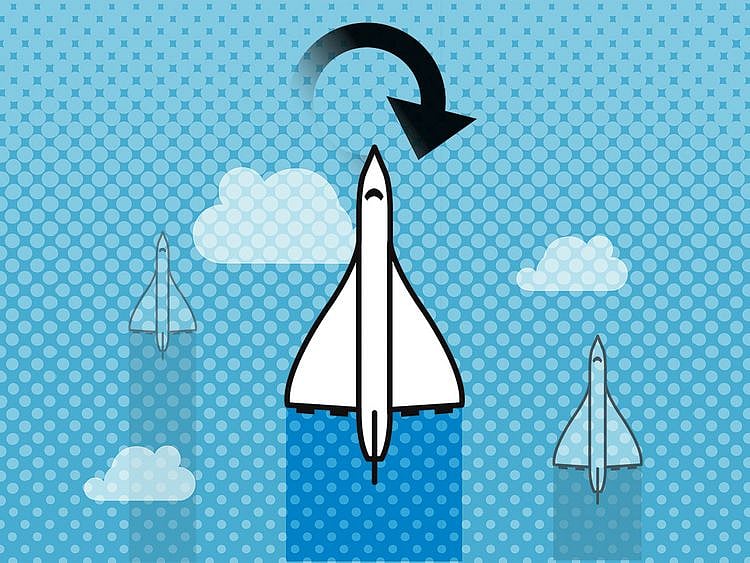Also In This Package
Dubai: After the Concorde was retired by British Airways and Air France in 2003, nobody thought that commercial supersonic flying would ever make a comeback… that is until now. An announcement by US-based United Airlines to add 15 supersonic jets to its fleet has set off a perfect storm in the the aviation industry.
The ‘Overture’ aircraft – produced by a Denver-based company called Boom - is to be rolled out in 2025, fly in 2026, and expected to carry passengers by 2029. The rationale behind United’s move can be explained in two words: shorter flights.
The airplane, which can fly at speeds of Mach 1.7 or roughly 2,000 kilometres per hour, will cut trans-Atlantic flight times by 50 per cent. This means a flight from Tokyo to Seattle will only take 4 hours and 30 minutes, compared to over eight hours now. A passenger can fly from Singapore to Dubai in a matter of 4 hours, instead of the seven taken today.
Challenges with supersonic
One of the biggest disadvantages is the ‘sonic boom’ - the shock waves created when an object travels through air faster than the speed of sound. This makes a distinctive sound, and although people on board don’t get to hear the boom, everyone else in the aircraft’s range does.
The issue gets a lot more serious when one realizes that aviation accounts for around 2.5 per cent of global carbon emissions, and fuel-guzzling supersonic planes are bound to make the problem worse. However, the Denver company Boom claims that Overture will be the first large commercial aircraft to be net-zero carbon from day one, by running on 100 per cent sustainable aviation fuel (SAF).
SAF, which is made using raw materials such as cooking oil and solid waste, can result in a reduction in carbon emissions compared to the traditional jet fuel it replaces. This sounds too good to be true and not everyone in the industry is convinced.
Hold on, not so fast
“The aircraft is not yet built… and there are almost always delays due to technical challenges with technological advances as well as cost overruns,” said John Strickland, Director of JLS Consulting. “There is also the question of attracting sufficient demand on a wide range of schedules - the only truly profitable route for Concorde was London-New York.
“Additionally, there will be environmental hurdles to cross, notwithstanding plans to use new generation engines and sustainable fuels.”
Strickland, , who previously held senior roles in British Airways and KLM, is not alone in casting doubts. A Linkedin post has referred to Aerion Supersonic, which like Boom planned to build business jets capable of flying nearly twice as fast as commercial aircraft, but was forced to shut down in May due to financial constraints.
“Before we all commence hyperventilating and thinking Aerion's shutdown was but a mere anomaly, I'm going to wait for some actual cash to change hands,” said an aviation industry source. “Until then, it's just hype.”
“I could order 10 or so myself with the same level of commitment and risk as UAL. {But) unless and until Boom demonstrates a new end-to-end rapid development and product delivery system that the US FAA (Federal Aviation Administrator) and airlines accept, color me a skeptic.”
Not all bad
Some have taken a more positive view of the development. “With the Boom announcement, United has articulated a bold and compelling vision to its stakeholders and shareholders - a good example of visionary storytelling, which is often lacking among airlines,” said Shashank Nigam, an aviation expert in a LinkedIn post. “It's what distinguishes winning companies from the rest of the crowd. This may very well help attract capital and talent to United in a way other airlines cannot.”
So, which way is Boom and its supersonic headed?
Concorde's legacy
This was the first supersonic jet to go commercial in 1976 and had a successful run for around 27 years before airlines abandoned the airplane due to several reasons. Although the aircraft was revolutionary in every sense of the term, it could only fly limited routes to begin with. Because the sonic boom from these airplanes would shatter mirrors and disturb people in population centers, it was decided that the Concorde would only be used for long-haul flights. On July 25 2000, an Air France Concorde jet crashed upon takeoff in Paris, killing everyone onboard as well as four people on the ground. Demand for the jet fell drastically after the incident and didn’t see an immediate bounce back due to the 9/11 attacks a year later, which wiped out air travel demand around the globe. On April 10, 2003, Air France and British Airways said they would retire their fleet of Concorde aircraft, mainly due to high maintenance costs.
Network Links
GN StoreDownload our app
© Al Nisr Publishing LLC 2025. All rights reserved.
